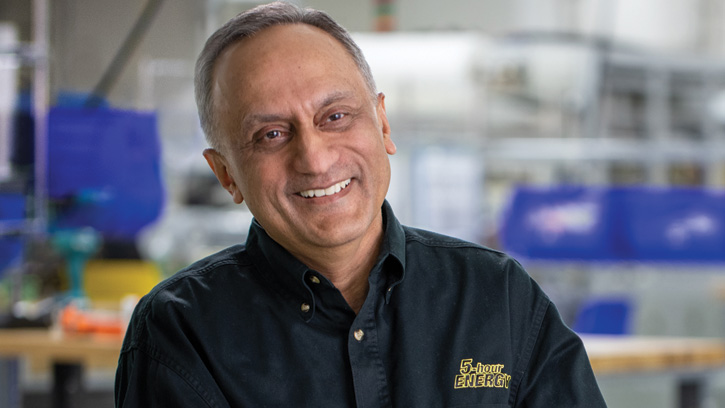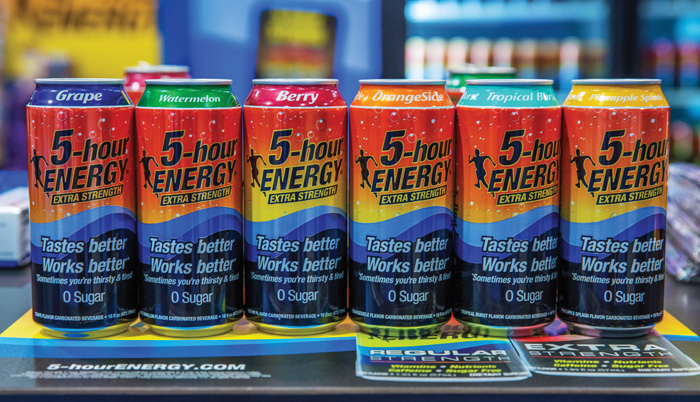A Category Pioneer Stays Energized
Startups & Innovators | INNOVATIONS
Two decades ago, Manoj Bhargava essentially invented an entire beverage category with 5-hour ENERGY two-ounce “shots,” earning him billionaire status and giving him the philanthropic resources to pursue technology solutions for some of the biggest challenges the poorest segments of the world’s population routinely face.
But Bhargava hasn’t removed himself from the commercial world. Far from it. About two years ago, he thrust 5-hour ENERGY for the first time into one of the most competitive spaces in the food business: energy beverages. And he continues to tinker personally with the shots-based brand that has become a multibillion-dollar global phenomenon.
Not more than a year after industry kingpin Coca-Cola retreated in defeat from the energy drink space after a short presence, the 5-hour ENERGY brand rolled out 16-ounce, carbonated drink versions of its basic formula to compete against Red Bull, Monster, PepsiCo’s Rockstar, and other long-established, powerful brands.
Believing in the Brand
Bhargava’s predecessors in the energy drink category have learned over the years exactly how to appeal to the mostly young, mostly male market for the caffeine-fueled beverage shots. But ultimately that didn’t dissuade Bhargava: He had succeeded by cultivating much the same market with 5-hour shots.
“We’ve got that established 5-hour ENERGY name, and we can leverage that name,” says Bhargava. “The jury is still out on [our success in energy beverages]. We’ve had to develop a whole new distribution system.” But he believes that the taste of 5-hour’s energy beverage is significantly differentiating the brand in the category already.
The inveterate entrepreneur came up with the shots about a quarter-century ago after imbibing an energy drink at a trade show and figuring he could do a better job of delivering ingredients that bolstered focus and concentration in a smaller package size.
The insight powered 5-hour ENERGY to an astonishing $1 billion in annual sales in just five years and set up a newly wealthy Bhargava to pursue serial entrepreneurial ventures that attack global challenges such as salvaging freshwater supplies, reinventing fertilizer for subsistence farmers, and even working toward a promising new therapy for Alzheimer’s disease.
“I like getting up in the morning and running like hell,” says the 70-year-old Bhargava, who, in earlier years was a monk in India and later a plastics industrialist. “And who cares what I’m passionate about? The needs are more important. The world is like a customer; you serve the customer.”
That kind of thinking finally persuaded Bhargava to enter the energy drinks derby after decades of staying away from it. “It makes sense with their successful platform in shots and a very well-known brand,” says Duane Stanford, editor in chief of Beverage Digest. “It’s almost derelict not to try to leverage that. But shots are so different. Do you want to let yourself get distracted?”
Jeffrey Sigouin is 5-hour ENERGY’s president and chief operating officer, and he provides a fuller explanation why the company decided to plunge into energy drinks and why it did so in the 16-ounce segment first instead of other common sizes, including eight and 12 ounces.
“That category had been experiencing explosive growth for a decade,” Sigouin says, “and we know from our research that consumers who join the 5-hour franchise typically come to us from energy drinks; about 30% of them use both. The people we lose, we’re losing to energy drinks.”
5-hour has dared to compete with Monster et al. despite the fact that “energy drinks typically sell for 40 cents to $1 less than our shots do,” Sigouin says.
“We had a value-proposition issue,” Sigouin says. “So when we went into energy drinks, we went with 16 ounces because of the high price, and we were very bullish that was the right move. Plus, there’s less discounting at that price point. We figured the 5-hour name would be enough to make it the right move.”
5-hour ENERGY entered the energy beverage category with six flavor-specific SKUs that contain about 230 mg of caffeine in each 16-ounce can versus a category-typical 130 mg, according to Sigouin.
Market Challenges
Succeeding in the energy drinks category “has been tougher sledding than we thought,” Sigouin concedes. “Our premium price coming out versus brands more established in that space gave us a difficult time getting trial.” And the spike in gasoline prices around the time of Russia’s invasion of Ukraine last year, he adds, spooked many of the category’s stalwart convenience store customers.
While Bhargava hired Sigouin to run the brand that produced his fortune, the founder remains deeply involved in the details of 5-hour ENERGY. For instance, flavor addition has been a primary brand extension strategy for shots for the last few years, and Bhargava personally approves and even helps formulate each one. “He approves every flavor because if it doesn’t taste good to him,” Sigouin says, “he doesn’t think anyone else is going to like it.”
Also, Bhargava, Sigouin, and other members of the 5-hour brain trust understand the strategic importance of flavor in both the shots and drinks categories. “Vitamins don’t taste very good,” especially in concentrated form in shots, Sigouin says. “Fruity flavors do a better job of masking ingredients and providing an overall consumer experience.”
The flavor game in energy beverages was easier when brands stuck with basic descriptors such as berry, orange, and grape. “The old thinking was that flavor should be very straightforward,” Sigouin says. “But we’ve learned from our counterparts in the energy drink world that you’ve got to keep it fresh, and maybe utilize things that aren’t descriptive at all.” Case in point: Bang Energy’s Rainbow Unicorn flavor. “We’ve borrowed from that and gotten a bit bolder, and it has been working,” he notes.
The company has applied its evolving approach to flavor initially in the shots category. And, true to form, Bhargava was active in coming up with one of the first “non-descriptive” flavors, Tropical Burst. He also played a key role in the final flavor profile of the next new shots flavor, Hawaiian Breeze, which in just several months has become a huge hit with 5-hour customers—up to No. 4 among the brand’s dozen or so flavors.
The energy drink category has changed to some extent with a growing emphasis on better-for-you, exemplified by PepsiCo’s recent investment in Celsius, a brand whose proposition has always been that its formula helped consumers burn calories.
“A lot of new [energy] entrants are going the route of natural and better-for-you and healthy and functional,” says Beverage Digest’s Stanford. “So the question is, are you getting in with an also-ran to the type of energy drinks with a huge following but not as much growth as new areas?”
Yet Bhargava’s company has stretched into the functional beverage arena with its recent introduction of True Hydration, a line of functional waters that takes advantage of the reverse-osmosis technology Bhargava’s team developed for addressing the problem of brackish water in less-developed countries.
“It’s all about absorption, which is about twice as fast as your body absorbs regular water,” Bhargava explains about True Hydration’s platform.
At the same time, what really excites Bhargava these days are his philanthropic pursuits, which are many but mainly involve health care, water, and energy—three pillars of life that remain shaky for billions around the globe.
“There’s not that much more I can do” with 5-hour, says Bhargava, who now operates an engineering and industrial research and development center to focus on his innovations. “I can increase 5-hour sales by a few percent, or I can do something much bigger,” he reflects.




